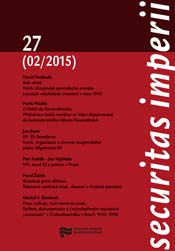Rok ohně. Vznik Ukrajinské povstalecké armády a pozadí volyňských masakrů v roce 1943
Year of fire. The creation of the Ukrainian Insurgent Army and the background to the Volhynia massacre in 1943
Author(s): David SvobodaSubject(s): Security and defense, Nationalism Studies, WW II and following years (1940 - 1949), History of Communism, Fascism, Nazism and WW II
Published by: Ústav pro studium totalitních režimů
Keywords: Ukrainian Insurgent Army;Volhynia;massacre;1943
Summary/Abstract: The study examines the internal dilemmas and debates in the heart of the Ukrainian insurgent movement on the eve of the tragedy caused by the Organisation of Ukrainian Nationalists (OUN) in Ukrainian Volhynia in 1943. The tragedy appears linked to events surrounding the creation of the Ukrainian Insurgent Army (UIA), intended as a response to changes occurring on the battlefields, meaning the prospect of a probable return of Soviet power to Western Ukrainian territory. Against a backdrop of intensifying Nazi terror in the Reichskommissariat Ukraine, the Ukrainian underground opted for a split from the German administration which it had hitherto successfully infiltrated in order to secure weapons and training for its cadres. After a wave of desertions by Ukrainian police officers their places were filled by local Poles for analogous reasons to those of the Ukrainians, an attempt to secure the Polish position prior to the return of the Soviets, with whom – like the Ukrainians – the Polish government in exile in London were in dispute over the eastern borders of Poland. The study takes a polemical position with regard to the tendency to explain the anti-Polish ethnic purge carried out in line with OUN and UIA ideological postulates as a kind of import from Nazi practices. It demonstrates that the programme positions of the Ukrainian nationalists in actual fact emphasised socialist and national liberation principles formulated in fundamental opposition to the practices of both totalitarian regimes, Nazi and Soviet. The decision to rid the Polish element from the disputed territory was later explained by the OUN as an instrument in the battle to remove the occupiers from Ukraine; however, the nationalists in reality also included the civilian Polish population in that category.
Journal: Securitas imperii
- Issue Year: 2015
- Issue No: 27
- Page Range: 12-42
- Page Count: 31
- Language: Czech

